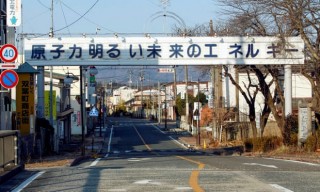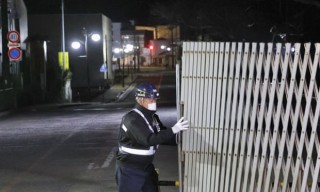Loading
Search
▼ Japan Lifts Evacuation Order For Town Hit By Fukushima Disaster
- Category:Other
Futaba to reopen for start of Olympic torch relay after being deserted for nine years
Japan has lifted an evacuation order for parts of a town in the shadow of the wrecked Fukushima Daiichi nuclear power plant, weeks before the area is to host the start of the Olympic torch relay.
Futaba, 2.4 miles (4km) west of the plant, has been almost deserted since the nuclear meltdown nine years ago, while other areas in the region have mounted a partial recovery after the government declared them safe for residents.
The start of the relay’s Japan leg at the end of the month is supposed to showcase Fukushima’s recovery from the world’s worst nuclear accident since Chernobyl in 1986, but some residents say their home towns may never return to normal.
Futaba’s 7,000 residents were forced to evacuate after the March 2011 disaster, which was triggered by a powerful earthquake and tsunami that killed more than 18,000 people along Japan’s north-east coast.
The reopening of a 1.5 sq mile area of Futaba means reconstruction workers can stay in accommodation near the railway station, but residents will not be able to return for another two years, when its water supply and other infrastructure will have been restored, according to local officials.
They will be able to enter and leave for short visits without going through security, and will no longer need to wear protective clothing, but will not be allowed to stay overnight.
While the coronavirus outbreak has prompted speculation that the Olympics could be cancelled or postponed, Japan’s government is keen to promote Tokyo 2020 as proof that the region, including Fukushima, has recovered from the triple disaster.
“I’m overwhelmed with emotion as we finally bring part of our town operations back to our home town,” said Futaba’s mayor, Shiro Izawa. “I pledge to push forward with our recovery and reconstruction.”
The domestic leg of the torch relay is due to begin on 26 March at J-Village, a football training complex that functioned for years as a logistics hub for crews working to control and decommission the damaged nuclear plant 12 miles away.
Japan has lifted an evacuation order for parts of a town in the shadow of the wrecked Fukushima Daiichi nuclear power plant, weeks before the area is to host the start of the Olympic torch relay.
Futaba, 2.4 miles (4km) west of the plant, has been almost deserted since the nuclear meltdown nine years ago, while other areas in the region have mounted a partial recovery after the government declared them safe for residents.
The start of the relay’s Japan leg at the end of the month is supposed to showcase Fukushima’s recovery from the world’s worst nuclear accident since Chernobyl in 1986, but some residents say their home towns may never return to normal.
Futaba’s 7,000 residents were forced to evacuate after the March 2011 disaster, which was triggered by a powerful earthquake and tsunami that killed more than 18,000 people along Japan’s north-east coast.
The reopening of a 1.5 sq mile area of Futaba means reconstruction workers can stay in accommodation near the railway station, but residents will not be able to return for another two years, when its water supply and other infrastructure will have been restored, according to local officials.
They will be able to enter and leave for short visits without going through security, and will no longer need to wear protective clothing, but will not be allowed to stay overnight.
While the coronavirus outbreak has prompted speculation that the Olympics could be cancelled or postponed, Japan’s government is keen to promote Tokyo 2020 as proof that the region, including Fukushima, has recovered from the triple disaster.
“I’m overwhelmed with emotion as we finally bring part of our town operations back to our home town,” said Futaba’s mayor, Shiro Izawa. “I pledge to push forward with our recovery and reconstruction.”
The domestic leg of the torch relay is due to begin on 26 March at J-Village, a football training complex that functioned for years as a logistics hub for crews working to control and decommission the damaged nuclear plant 12 miles away.
Although organisers have said the route is subject to change, the torch is scheduled to pass through Futaba later the same day, before being taken through other parts of Fukushima prefecture over the following two days.
“In addition to building excitement across the country ahead of the Tokyo 2020 Games and promoting the Olympic values, the Olympic torch relay aims to demonstrate solidarity with the regions still recovering from the 2011 earthquake and tsunami,” the organisers said last month.
More than 160,000 people were forced to flee their homes during the Fukushima meltdown. Many have decided not to return, despite government reassurances on safety, and many of those who have returned are older residents.
Futaba is no exception, with just 10% of residents saying they intend to return. Some, particularly those with young children, are concerned about radiation levels, while others have built new lives elsewhere.
Yuji Onuma, a Futaba resident, said recent work to repair streets and decontaminate the town centre was designed to give the world a false impression before the Olympic torch relay.
“I wish they wouldn’t hold the relay here,” Onuma told Reuters. Pointing at workers repaving a road expected to be on the relay route, he added: “Their number one aim is to show people how much we’ve recovered. I don’t think people will understand anything by just seeing cleaned-up tracts of land.”
Radiation readings in the air taken in February near Futaba’s railway station were around 0.28 microsieverts per hour, higher than the government-set target of 0.23 microsieverts an hour.
Another part of the town had a reading of 4.64 microsieverts per hour on the same day, meaning a person would reach the annual exposure upper limit of 1 millisievert, recommended by the International Commission on Radiological Protection, in just nine days.
The torch is due to pass through the village of Iitate the following day, but campaigners this week described the relay as inappropriate and warned they had found radiation “hotspots” in the village.
In a survey of 69 locations along and around the proposed relay route, the grassroots group the Radioactivity Monitoring Centre for Citizens said it had found 44 sites with radioactive levels above 0.23 microsieverts per hour, including one “severe hotspot” of 0.85 microsieverts per hour along the torch relay route.
The discovery of hotspots near J-Village by Greenpeace Japan at the end of last year prompted the environment ministry and the nuclear plant’s operator, Tokyo Electric Power, to perform extra decontamination work.
While some independent monitors have said the discovery of isolated hotspots does not present an accurate picture of the overall situation in Fukushima, Nobuyoshi Ito, an Iitate farmer, said the civic group’s findings cast doubts on government claims that decontamination work had been a success.
“Radiation exposure for runners passing along the route may not be very high, but the overall situation in places like Iitate is severe,” Ito said. “Levels are several times to as many as 20 times higher in the village than they were before the disaster, and people who moved back have to put up with that 24 hours a day, 365 days a year.”
Of Iitate’s pre-disaster population of 6,100, only 1,200 people have returned, Ito said. “The small number of people coming means that the nuclear disaster is not over yet. The truth is that full recovery from a nuclear disaster like this is just not possible.”
“In addition to building excitement across the country ahead of the Tokyo 2020 Games and promoting the Olympic values, the Olympic torch relay aims to demonstrate solidarity with the regions still recovering from the 2011 earthquake and tsunami,” the organisers said last month.
More than 160,000 people were forced to flee their homes during the Fukushima meltdown. Many have decided not to return, despite government reassurances on safety, and many of those who have returned are older residents.
Futaba is no exception, with just 10% of residents saying they intend to return. Some, particularly those with young children, are concerned about radiation levels, while others have built new lives elsewhere.
Yuji Onuma, a Futaba resident, said recent work to repair streets and decontaminate the town centre was designed to give the world a false impression before the Olympic torch relay.
“I wish they wouldn’t hold the relay here,” Onuma told Reuters. Pointing at workers repaving a road expected to be on the relay route, he added: “Their number one aim is to show people how much we’ve recovered. I don’t think people will understand anything by just seeing cleaned-up tracts of land.”
Radiation readings in the air taken in February near Futaba’s railway station were around 0.28 microsieverts per hour, higher than the government-set target of 0.23 microsieverts an hour.
Another part of the town had a reading of 4.64 microsieverts per hour on the same day, meaning a person would reach the annual exposure upper limit of 1 millisievert, recommended by the International Commission on Radiological Protection, in just nine days.
The torch is due to pass through the village of Iitate the following day, but campaigners this week described the relay as inappropriate and warned they had found radiation “hotspots” in the village.
In a survey of 69 locations along and around the proposed relay route, the grassroots group the Radioactivity Monitoring Centre for Citizens said it had found 44 sites with radioactive levels above 0.23 microsieverts per hour, including one “severe hotspot” of 0.85 microsieverts per hour along the torch relay route.
The discovery of hotspots near J-Village by Greenpeace Japan at the end of last year prompted the environment ministry and the nuclear plant’s operator, Tokyo Electric Power, to perform extra decontamination work.
While some independent monitors have said the discovery of isolated hotspots does not present an accurate picture of the overall situation in Fukushima, Nobuyoshi Ito, an Iitate farmer, said the civic group’s findings cast doubts on government claims that decontamination work had been a success.
“Radiation exposure for runners passing along the route may not be very high, but the overall situation in places like Iitate is severe,” Ito said. “Levels are several times to as many as 20 times higher in the village than they were before the disaster, and people who moved back have to put up with that 24 hours a day, 365 days a year.”
Of Iitate’s pre-disaster population of 6,100, only 1,200 people have returned, Ito said. “The small number of people coming means that the nuclear disaster is not over yet. The truth is that full recovery from a nuclear disaster like this is just not possible.”
- March 4, 2020
- Comment (0)
- Trackback(0)



